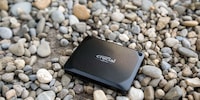

With Thunderbolt 5 to the top: Lacie Rugged Pro 5 SSD tested
Thanks to Thunderbolt 5, the Lacie Rugged Pro 5 promises fast data transfers. It also fulfils this promise, but cannot maintain the high speed for long.
Thunderbolt 5 promises speeds of up to 80 gigabits per second (Gbit/s). It is obvious that external SSDs will benefit from this. With the Rugged Pro 5, Lacie was one of the first to release an external storage device with the fast interface protocol. However, only a few devices support it so far. For example, Apple systems with an M4 chip. Only a few mainboards on Windows PCs can support it - with an additional plug-in card. I had to wait several months for one, only to realise that my tested mainboard was not compatible. With the ROG Strix Scar 18, I finally got my hands on a notebook to carry out this test.
Long story short: The Lacie Rugged Pro 5 is faster than all the external SSDs I've tested so far. But it quickly runs out of breath.
The Lacie Rugged Pro 5 in detail
At 9.8 × 6.5 × 1.7 centimetres, the Rugged Pro 5 is one of the largest external SSDs I've come across in recent years. It also weighs 150 grams, which makes it a real lump.
The Rugged Pro 5 is encased in blue rubber. It is certified to IP68. This means that it is not affected by dust and can withstand complete immersion in water up to a depth of 1.5 metres for 30 minutes. It should also be able to withstand drops from a height of up to three metres. There is one last «is also said to» be able to be rolled over by a vehicle weighing up to two tonnes without breaking.

The Rugged Pro 5 is available in two and four terabyte (TB) storage sizes. An unspecified Seagate SSD in the PCIe 4.0 standard is installed. I assume that the NAND memory is TLC. NAND is a non-volatile memory technology that does not require electricity to store data. TLC stands for «Triple-Level-Cell». This means that 3 states can be stored per memory cell. The manufacturer's warranty is five years.
For data transfer, Lacie specifies 6700 megabytes per second (MB/s) for reading and 5300 MB/s for writing. However, these values only apply if you have connected the SSD to a Thunderbolt 5-capable device. Otherwise, the speed is reduced accordingly.
The scope of delivery also includes a Thunderbolt 5 cable with two USB-C ports. As Thunderbolt uses the same connections as USB technology, you should not mix them up.
Reading: clear lead
I measure the read speed with the CrystalDiskMark programme. Here, the Rugged Pro 5 clearly outperforms the competition in the form of the Samsung T9, the fastest external SSD I have tested to date. However, the T9 comes in the USB 3.2 Gen2x2 standard, which only allows «» speeds of up to 20 Gbit/s. In view of this, the differences are not as radical as the standard would suggest. In addition, the SSD does not even reach the speed specified by the manufacturer. Instead of 6700 MB/s, it is 6134 MB/s.
The first chart below refers to sequential reading, the second to random reading. If you are employed with large files, the first is relevant for you, with small files the second.
In a practical test, I copy a 10 gigabyte (GB) file from the Rugged Pro 5 to a RAM disc. The RAM disc ensures that the SSD is the bottleneck, as the disc achieves a much higher write and read rate. Here too, the Lacie SSD clearly beats the Samsung SSD, but not as clearly as in the theoretical test.
Writing: new peak values
The differences are smaller when it comes to writing. The Rugged Pro 5 is twice as fast as the T9. However, as with reading, the Lacie SSD does not achieve the values specified by the manufacturer.
Also here: The first graph refers to sequential writing, the second to random writing. If you are employed with large files, the first is relevant for you, with small files the second.
In a practical test, I copy a 10 GB file from a RAM disc to the SSD. As with the read test, this ensures that the SSD is the bottleneck, as the disc achieves a much higher read and write rate. Here too, the Lacie SSD beats the Samsung SSD, but the difference is not as significant as the standard would suggest, as is the case with reading.
To test how the SSD behaves when writing data continuously, I repeatedly write the 10 GB test file from the RAM disc to the SSD using a batch command. This allows me to determine when it starts to throttle down. The Rugged Pro 5 hits the brakes after 50 GB of written data: there is only 360 MB/s left. The 50 GB is also the available cache. The T9 does this much better. It only slows down after 200 GB of written data - and only to an average of 800 MB/s. Both SSDs can maintain their throttled value until they are full.
Copying: a clear winner
When copying, i.e. reading and writing to the SSD at the same time, I duplicate the 10 GB file. Here too, the Rugged Pro 5 beats the T9 by around double. However, the same limitation applies here as for writing: After 50 GB of written data, the Lacie SSD slows down significantly.
Office: another top value
The Rugged Pro 5 clearly sets itself apart in Office applications: It achieves a score more than twice as high as the T9. You should bear in mind that the T9 is already as fast as an arrow in such applications. You will feel the benchmark differences less in reality than on paper.
Gaming: and another new peak value
The Rugged Pro 5 also clearly outperforms the T9 in the 3DMark gaming benchmark. In contrast to office applications, you will certainly notice the difference when gaming.
How the SSD behaves when it is 80 per cent full
All previous tests were carried out with an empty SSD. However, you usually fill up your drive over time. Thanks to the 50 GB cache memory, the Rugged Pro 5 loses little of its performance even when full. Across all benchmarks, the average loss is five per cent.
Temperatures: stays cool
The Rugged Pro 5 remains surprisingly cool when tested in the continuous write test: It only reaches a temperature of 48 degrees Celsius. This is significantly cooler than the T9, which heats up to 64 degrees Celsius when tested in the same way.
In a nutshell
Damn fast, damn expensive
The Lacie Rugged Pro 5 comes out on top in my tests. Thanks to IP68 certification, it really is "rugged", i.e. made for travelling. With Thunderbolt 5, however, it has a clear advantage over the Samsung T9 with USB 3.2 Gen 2x2. It is not able to exploit this advantage as clearly as the standard would suggest. Thunderbolt 5 offers up to four times the speed - but in my tests, the Rugged Pro 5 is a maximum of three times as fast as the T9. In most cases, the difference is significantly less, especially in the practical tests.
The Lacie SSD even has a weakness when it comes to writing and copying: Once the 50 GB cache is used up, the write speed falls below that of the T9. Another minus point is the high price: The Rugged Pro 5 currently (as of 18 June 2025) costs almost twice as much as the T9. Last but not least, the standard itself is a weak point: there are hardly any Thunderbolt 5-capable devices.
I can therefore only recommend the Rugged Pro 5 to those who can use Thunderbolt 5 at all and always want the absolute fastest. Everyone else is also well served with a less fast external SSD.
Pro
- high speeds
- IP68 certification
- Thunderbolt 5
Contra
- Low speed when the cache is used up
- High price
- Low distribution of Thunderbolt 5 to date

From big data to big brother, Cyborgs to Sci-Fi. All aspects of technology and society fascinate me.


